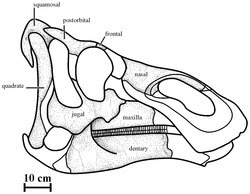Kundurosaurus
|
Kundurosaurus Temporal range: Late Cretaceous, 67–66 Ma |
|
|---|---|
 |
|
| Restoration of the skull | |
| Scientific classification | |
| Kingdom: | Animalia |
| Phylum: | Chordata |
| Class: | Reptilia |
| Clade: | Dinosauria |
| Order: | †Ornithischia |
| Suborder: | †Ornithopoda |
| Family: | †Hadrosauridae |
| Subfamily: | †Saurolophinae |
| Genus: |
†Kundurosaurus Godefroit et al., 2012 |
| Type species | |
|
†Kundurosaurus nagornyi Godefroit et al., 2012 |
|
Kundurosaurus is an extinct genus of saurolophine hadrosaurid dinosaur known from the Latest Cretaceous (probably Late Maastrichtian stage) of Amur Region, Far Eastern Russia. It contains a single species, Kundurosaurus nagornyi.
Kundurosaurus is known from holotype AENM 2/921, a partial, disarticulated skull, including a nearly complete braincase (AENM 2/921 1-2), two quadrates (3-4), squamosal (5), postorbital (6), frontal (7) and parietal (8) bones. The referred specimens are AENM 2/45-46, two jugals; AENM 2/83-84, 2/86, maxillae; AENM 2/57-58, nasals; AENM 2/48, postorbital; AENM 2/19, quadrate; AENM 2/121, 2/928 partial braincases; AENM 2/846, 2/902, dentaries; AENM 2/906, scapula; AENM 2/913, sternal; AENM 2/117, 2/903, 2/907-908, humeri; AENM 2/905, ulna; AENM 2/904, radius; AENM 2/922, nearly complete pelvic girdle and associated sacral elements. These were found at the same level as the holotype, but may belong to other individuals. All specimens are housed in the Amur Natural History Museum of the Institute of Geology and Nature Management, Russia.
All Kundurosaurus specimens were collected in the Kundur locality. The site belongs to the Wodehouseia spinata – Aquilapollenites subtilis palynozone, dating to the Maastrichtian stage, probably the Late Maastrichtian, of the Late Cretaceous period, about 67-66 million years ago. The Kundur site was discovered by Vladimir A. Nagorny in 1990. He collected fossil bones in a road section along the Chita – Khabarovsk highway near the village of Kundur and sent them to Yuri L. Bolotsky. Large-scale excavations started at Kundur in 1999. Besides the abundant Olorotitan arharensis material, it has yielded many disarticulated saurolophine specimens. All these specimens were assigned to Kundurosaurus because the describers considered the recovered material to be homogeneous, and suggested that there is no reason to believe that more than one single saurolophine taxon lived in the Kundur area by latest Cretaceous period. Kundur is one of four rich dinosaur localities that have been discovered in the southeastern part ("Lower Zeya depression") of Zeya-Bureya sedimentary basin, eastern Asia: Jiayin and Wulaga localities are located in the Yuliangze Formation of northern Heilongjiang Province, China and Blagoveschensk and Kundur localities are located in the Udurchukan Formation of southern Amur Region, Russia. In each locality, the dinosaur fauna is largely dominated by lambeosaurine hadrosaurids (Charonosaurus jiayinensis and some non-diagnostic material of Mandschurosaurus amurensis from Jiayin, Sahaliyania from Wulaga, Amurosaurus from Blagoveschensk, and Olorotitan from Kundur), but the indeterminate hadrosaurid Arkharavia, from Kundur, and saurolophine (non-crested or solid-crested) hadrosaurids are also represented (Saurolophus kryschtofovici and other non-diagnostic material of M. amurensis from Jiayin, Wulagasaurus from Wulaga, Kerberosaurus from Blagoveschensk and Kundurosaurus from Kundur).
...
Wikipedia
